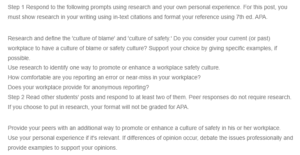Nursing Discussion – A Blame-Free Culture
A culture of blame grows out of irresponsibility and the inability of care providers to be accountable for their mistakes or failures. In other words, a culture of blame is a lack of ownership for roles, mistakes, or failures within the position for which one is responsible and accountable. On the other hand, a culture of safety from a personal understanding is the development of attitudes among the staff within a health care setting, especially in nursing, in which all of the staff are focused on their safety and that of others by eliminating risk factors within their work environment. In a safety culture, all of the staff members are actively engaged within their work environment in identifying and eliminating hazards. My current workplace has a culture of safety. For example, everyone is actively involved in reducing medical errors. They work collaboratively to reduce the chances of such errors occurring.
Based on evidence from research, one of the ways the culture of safety in the workplace can be promoted and enhanced is through organizational learning (Akologo et al., 2019). Organizational learning helps nurses grow their competency in safety within the works, including knowledge of medication administration and being observant of risks. Consistently, I am very comfortable reporting an error or near-miss in my workplace, as we are all encouraged to report such occurrences. The people I work with also understand the need for accountability and responsibility. We have a rule that either somebody owns up to their mistakes or near-misses and reports them, or somebody else will. Management also focuses on helping people resolve errors and near-misses rather than punishing them. Getting caught reporting on workmates risks the loss of a friend and having guilty feelings (Levine et al., 2020). Therefore, my workplace has set up channels for anonymous reporting, including a suggestion box and incident reporting boxes across the facility.
References
Akologo, A., Abuosi, A. A., & Anaba, E. A. (2019). A cross-sectional survey on patient safety culture among healthcare providers in the Upper East region of Ghana. PLOS ONE, 14(8), e0221208. https://doi.org/10.1371/JOURNAL.PONE.0221208
Levine, K. J., Carmody, M., & Silk, K. J. (2020). The influence of organizational culture, climate, and commitment on speaking up about medical errors. Journal of Nursing Management, 28(1), 130–138. https://doi.org/10.1111/JONM.12906
ORDER A PLAGIARISM-FREE PAPER HERE
We’ll write everything from scratch
Question
Step 1 Respond to the following prompts using research and your own personal experience. For this post, you must show research in your writing using in-text citations and format your reference using 7th ed. APA.

Nursing Discussion – A Blame-Free Culture
Research and define the ‘culture of blame’ and ‘culture of safety.’ Do you consider your current (or past) workplace to have a culture of blame or safety culture? Support your choice by giving specific examples, if possible.
Use research to identify one way to promote or enhance a workplace safety culture.
How comfortable are you reporting an error or near-miss in your workplace?
Does your workplace provide for anonymous reporting?
Step 2 Read other students’ posts and respond to at least two of them. Peer responses do not require research. If you choose to put in research, your format will not be graded for APA.
Provide your peers with an additional way to promote or enhance a culture of safety in his or her workplace.
Use your personal experience if it’s relevant. If differences of opinion occur, debate the issues professionally and provide examples to support your opinions.


